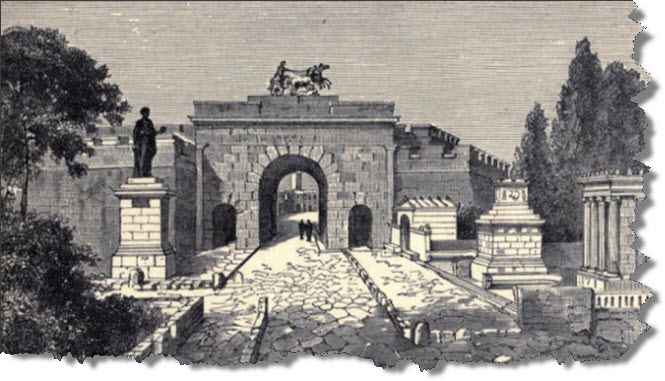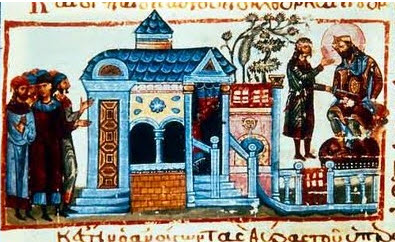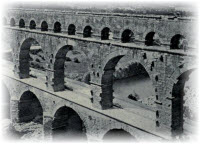The Byzantine Empire
| Roman Empire | Browse Topics | Alphabetical index | Site Map | Site News | Links |
 |
|||||

Byzantine Art
The reign of Emperor Justinian I., known as the Age of Justinian, was the most efficient in the history of the empire.
It was distinguished by the rise of painting, sculpture, and architecture. In this reign the empire was extended; the great churches were constructed, including Saint Sophia and several hundreds others; and the famous "Code of Emperor Justinian" was written. He was succeeded by Emperor Justinian II., who was unfortunately harrassed by the Persians in the East and the Avars in the West. His reign was followed by Maurice, a weak and lawless ruler, who was overthrown by Heraclius. The latter reigned successfully from 610 to 641. His achievements in war are regarded equal to those of Scipio and Hannibal. Though several possessions were lost, those remaining were closely united and the Byzantine empire became more distinctly Greek.
From 716 to 1057 followed a period of prosperity. It was marked by successful defenses
against the Bulgarians and Saracens. The period witnessed the great internal religious
controversy that tended to weaken the empire against foreign foes. The controversy was
between the Iconoclasts and the Established Church. The former, who opposed the presence
of images in places of public worship, were led principally by Leo III. This long dispute
resulted in the separation of the Greek Church from the Roman Catholic Church in the last
half of the 9th century; the formal separation occurred at the excommunication of the
Greek Church in 1054. This schism was to have profound effects on the history of Europe,
as the western nations were reluctant to aid the Byzantines in their wars against the
muslims and in fact sometimes came into open conflict with the Byzantine Empire, further
weakening it, and allowing the muslim empire to expand at the expense of Byzantine
territory.
In this period the empire possessed various distinguished though often cruel rulers, among them Empress Irene, who sought to unite the Eastern and Western empires by an endeavor to marry Charlemagne (who had assumed the crown of the Western The Roman Empire, though in fact he was the ruler of the Franks, a barbarian tribe based mainly in present day France). In order to carry out her scheme, the Empress blinded her own son so that he could not assume the throne, but she failed to achieve a union of the Byzantine empire with the Frankish empire pretending to be the restored The Roman Empire, for want of support in her own nation. In the reign of Constantine VII., in the middle of the 10th century, many Russian and Hungarian princes embraced Christianity and Christianized their people.
In the beginning of the 11th century the Bulgarians were conquered, but the Turks began to threaten Italy from the East, while the Normans became aggressive from the West.
From 1057 to 1204 the empire gave evidence of a slow but constant decline, owing to the
attacks of the Crusaders and the rise of Turkish power. The Crusaders had a marked effect
upon Constantinople as they pressed forward to Asia Minor and finally came into open
conflict with the emperors. Constantinople was captured by the Crusaders in 1203, and
again in 1204.
From 1204 to 1261 the crusaders, known as the Latins because they originated from the Latin or Western part of Europe, occupied the empire. The Byzantine empire was now commonly called the Latin Empire of Rumelia, and Count Baldwin of Flanders became the first emperor.
At this time the Byzantine empire was divided into various kingdoms and was made tributary to the Venetians and French. Latin occupation was marked by harmful influences, since both art and culture degenerated, and its former greatness was forever lost. In 1261 the Latin Empire vanished, and the Byzantine emperors regained control, but the empire was fragmented and many of the smaller principalities still remained under foreign control.
From 1261 to 1453 the final fall was accomplished by the rapid rise of Turkish power. A
dynasty was founded by Michael Palaeologus, the ruler of Nicaea, in 1261, which remained
in control until the final fall of the empire, and is known as the dynasty of Palaeologi.
He made fruitless efforts to reconcile the Latin churches and to unite the Greeks as one
mighty people. He was hard pressed by the Turks, but they became even more powerful in the
reign of his son, Andronicus II., who lost Adrianople, in 1361, and afterward Macedonia
and Albania.
Sultan Amurath was succeeded by Bajazet, a strong Turkish warrior, who captured Philadelphia, in Asia Minor, and laid siege to Constantinople, but the city was saved by the Tartars under Timour, who invaded Western Asia, which caused a retreat of the Turks to defend their countries in the East. Various rulers followed successively until the Turks attacked Constantinople with an army of 400,000 men under Sultan Mohammed, on April 6, 1453.
The once powerful, centuries old Byzantine Empire, the heir to Rome, had shrunk to one city defended by a garrison of 8,000 men. The Byzantines made a noble defense, but they were finally conquered, and Constantine, the last of the Byzantine emperors, was slain in the battle. The cross on the dome of Saint Sophia was replaced by the crescent of the Moslem. Christianity was exterminated, and the surviving inhabitants were sold into slavery.
The Byzantine Empire had not stood in vain. It served as a mighty bulwark against the
rising power of the Turks until the spark of Western culture and the spirit of advancement
were fanned into a flame that developed the highest learning of modern civilization. It
was the means of protecting the treasures of ancient Greece and Rome from destruction by
the Western tribes in the long period of the Middle Ages, preserving them safely until the
rise of learning, which spread like fire over Western Europe after the fall of the last
Constantine.

Roman Aqueducts made possible the growth of Roman cities and permitted the development of a large urban civilization.
| Privacy Policy | Site News | About | Site Map |